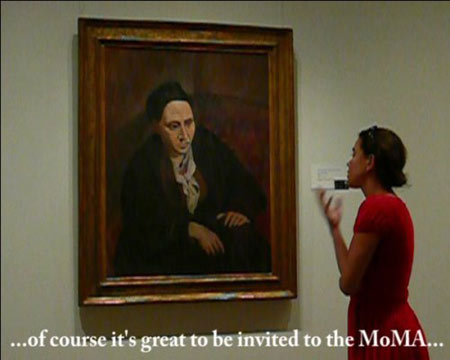
hug us on facebook
or join the gang and post yourself
• elsewhere
Hall Of Fame
Directors Lounge
is kindly supported by

Cocoon and other Swan Songs — Felice Naomi Wonnenberg
Kuratiert von Klaus W. Eisenlohr
F
elice Naomi Wonnenberg entschied sich, nicht den leichten Weg zu nehmen, mit ihren Film- und Videoarbeiten. Ihr Stil changiert zwischen der Bildtradition des Experimentalfilmes einerseits und andererseits, der am Fernsehrealismus orientierten Bildform. Dabei wäre es falsch zu sagen, sie benütze diese unterschiedlichen Stilmittel nur um bestimmte Aussagen zu machen, vielmehr scheint sie eine Neugier zu treiben, die allen vorschnellen Urteilen entgeht und diese dekonstruiert. Es ist eine Neugier auf die Bedeutung von Bildern und Metaphern und was sich hinter diesen verbergen mag. Eine Neugier auch, die nicht vor Bildern eigener Obsessionen halt macht, oder vor der Neubetrachtung eingefahrener politischer Themen, wie der Beziehung des Westens zum Nahen Osten.
So etwa in "A Turtle's Life in the Middle East": ein palästinensischer jungen Mann schildert Jugenderinnerungen von seinem gewalttätigen Umgang mit Schildkröten, und ein junger Israeli wehrt alle Tragik zum Thema Attentate in Israel ab. Die Inhalte beider Tonspuren verschmelzen miteinander und mit Bildern von Behausungen und Verletzungen, die wiederum in Griechenland und Tunesien aufgenommen sind. Es entsteht ein filmisches Ganzes, das existentiellen Bedeutungen nachhört und einem zweiten überdenken des Gesehenen und Gehörten nachspürt.
Auch die an surrealistische Collage erinnernden Bildfolgen in “On the Edge of Swans" eröffnen einen Assoziationraum, der bildhaft-erotischen Verstrickungen und scheiternden Geschlechterverhältnissen eher mit gesteigerter Neugierde nachfühlt anstatt diese wertend zu erörtern.
Die Entscheidung, seit nunmehr zwei Jahren in Israel zu leben (mit einem zweiten Wohnsitz in Berlin) spielt sicherlich eine große Rolle für die Annäherung an orientalische Metaphern und an die Auseinandersetzung mit dem "Orientbild" des Westens. Nicht zuletzt gibt es bei Felice Naomi Wonnenberg aber noch eine weitere treibende Kraft: die Sehnsucht nach Schönheit.
Mit ihrem filmischen und künstlerischen Arbeiten geht sie so (um es mit Hildegard Knef zu sagen) ‘den weiten Weg’, den wir nun glücklicherweise auf der Filmleinwand ein Stück weit mitverfolgen können.
Felice Naomi Wonnenberg lebt in Israel und Berlin und präsentiert ihre Arbeiten persönlich in der Z-Bar. Das Filmprogramm ist Teil der Sommerscreenings "A Summer Evening With..." der Directors Lounge und wird kuratiert von Klaus W. Eisenlohr.
some of the films included:Jewel Garden experimental documentary, digital video, 10 mins, 2006 "...a delightful...wonderfully inventive film and...great addition to our program" writes William Sloan, curator of MoMA - The Museum of Modern Art, NY Portrait of an old 2nd-hand jewelry dealer on Berlin's shopping-mile Ku'damm. In an uncut 9 min. close-up shot, the camera glides over the glittering necklaces, war medals, Jewish Chanukah candlesticks, worn-out wedding rings and other broken dreams on sale. We never get to see the dealer, but we do hear him chat about his theories on love.
Cocoon, Performance on digital video, 9 mins, 2007 Some young men wander in the desert. In a cave they make the chance discovery of a giant cocoon with female content... In the encounter the young men devour the cocoon, but then as they penetrate into it they do not even realize that the content of the cocoon is a woman. Their actions appear as a fickle mood of fate. The men destroy the woman's fragile protective wrap for a moments' culinary pleasure and leave her behind - deprived of her protection, desinterested in her fate. Cocoon is a video that brings visual inspirations from Man Ray's nude photographies and the sexy armpit from Luis Bunuel and Salvador Dali's Chien Chien Andalou onto a feminist panel. The viewers' sexual expectations are first stimulated and then playfully led ad absurdum. The cocoon is the poor worm's / woman's longing for transformation, the attempt to withdraw from the world in order to emerge as a new magnificent self. As in many of Wonnenberg's films the puzzling sexual encounters between man and woman remain unsatisfactory. Both parties do not recognize the others needs and desires and their physical contact remains at once naive and yet cruel and destructive. The location of the scenes is a metaphysical place in itself: Cocoon was shot on location at the caves of Qumran in the Judean desert on the shore of the Dead Sea, where in 1947 a Bedouin boy discovered, by coincidence, the oldest surviving Torah scrolls.
The Orient through Western Eyes video collage, 8 min, 2007 A video collage juxtaposing clips from early silent movies to modern fantasy blockbusters to show how the West has constructed its own image of "the Orient". This art video commissioned by Israel's biggest art museum The Israel Museum Jerusalem was shown in conjunction with its exhibition Eden- East and West. It is a critical visual analysis of the West's cinematographic fantasies of "the Orient". The Middle East and the Land of Israel were an important locus of Western longing, curiosity, fantasy, and apprehension of the “Other”, and these feelings were articulated visually by many artists. This art video juxtaposes clippings from existing footage of Hollywood movies, from their beginnings in the early days of silent movies (such as DeMille’s monumental biblical epics) to contemporary fantasy Blockbusters (such as The Lord of the Rings). The visual confrontations demonstrate how the West has constructed its own image of "the Jew", "the Arab", "the Orient" or -in brief - the necessary and fondly hated "Other" for its own psychological needs.
A Turtle‘s Life in the Middle East, 16 mm and Super 8 black/white and color, 10 mins, 2003 3Sat / ARTE Prize for Artistic Innovation This is an experimental documentary about fear and how to deal with it after a terror attack. The basis of the film is the childhood memory of a Palestinian, in which the need of protection turned into perverted and absurd violence. The child confronted his seeming enemies, the turtles. "I declared war on turtles...Until they were dead. Then I‘d be very satisfied.“ Contrasting this are an Israeli‘s angry comments. He cannot stand his German girlfriend's questioning him about terror attacks, which she needs for her documentary film, anymore. The images of the film stand in contrast to the interviews: a group of nervous birds and architectural shots of a prison relay the fear that the narrators struggle to repress. The film ends in bitter words juxtaposed with pictures of hope.
mehr auf richfilm

![]()
Hall of Fame Directors Lounge is kindly supported by




 • Cafe Dix in der Berlinischen Galerie • Scala e.V.
• Cafe Dix in der Berlinischen Galerie • Scala e.V.
our heroes: placebo FX, Fragments, Berliner Licht & Silber, Cinema Desaster, monitoranimation.de,
Joppel-Bürkle IT,SIEBENGRUENDE, IF Museum/Inner Spaces, Fanhall Studio, Rote Loge


